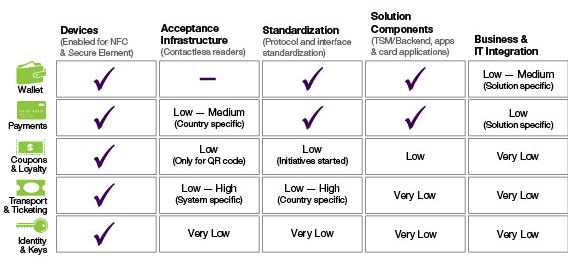Sep
3
How a mobile wallet can be used?- A full day example

So far in my mobile wallet series, I’ve introduced and offered a definition of what a mobile wallet is: a container to store digitized valuables for authorization. I broke down the concept into proximity and remote mobile wallets, as well as umbrella and integrated wallets. In the most recent post, I discussed the many mobile wallet services that are or could soon become available. Now let’s look at what this all looks like in the real world.
A day in the life of a mobile wallet
Meet Anna. An example of her full day with a proximity wallet is shown in Figure 1.

Using a mobile wallet
This is just a sampling of the many ways that a proximity wallet can be used.
Grab a breakfast snack
A mobile wallet makes it easy for users to pay for food or other purchases with a quick tap of their phone on an NFC payment acceptance terminal. Anna quickly gets a breakfast snack in the bakery; she pays with her phone and doesn’t have to deal with any pocket change.
Purchase tickets on the run
Users can purchase tickets at any time and store them in the mobile wallet on their smartphone, where they can be easily accessed later. Anna stores her train ticket in her mobile wallet for access at entry gates or for approval by ticket controllers; the validity of the ticket is checked with a touch on the gate or the ticket controller’s smartphone.
Open your house for the cleaner
From their smartphones, users can provide temporary access keys to another person’s mobile wallet. While sitting on the train, Anna issues a temporary access key to her cleaning lady’s phone for two hours.
Access your company network
A mobile wallet can provide remote access to a company’s network, allowing employees to work at home, on the train or while sitting in a waiting room. Secured by the tamper-resistant token in the mobile wallet, Anna has secure remote access to her company’s network with her mobile ID stored in the mobile wallet. This enables her to work on the train.
Get a shared car
Mobile wallet users can also easily access shared cars with a mobile wallet. The access keys are sent straight to the wallet at the appropriate time when the car has been reserved. After her arrival from the train, Anna takes the next available shared car, with the key stored in her mobile wallet. Her driving license, also stored in the mobile wallet, was checked before granting access to the car, and the usage fee for the car will be paid using the wallet.
Do some personalized shopping
By learning user preferences, a mobile wallet can provide shopping experiences tailored to an individual’s interests. This might include store recommendations and personalized offers or discounts. When entering a shopping center, Anna receives personalized offerings and is guided through the shops to select some goodies.
Get a lower price on a purchase
Users who subscribe to loyalty programs can receive coupons in their mobile wallet when they are physically near to a vendor. When Anna gets close to her hotel, she receives a coupon for a hairdresser around the corner. She takes the service, redeems the coupon and earns loyalty points by paying with a single touch of her phone.
Enter the stadium for a concert
Tickets for events can be stored in the mobile wallet too, so when the day of the show arrives, there’s nothing to print and no paper ticket to keep track of. Just store the electronic ticket in the mobile wallet. Anna is going to a concert. She is able to enter quickly and can use her mobile wallet to pay at booths in the stadium and access VIP areas with a touch.
Check in at a hotel
Checking in at a hotel with mobile access keys is easy. The keys are already in the mobile wallet at the time of check in. After a long day, Anna is happy that she has hotel access keys on her phone and can quickly get to her room.
Over the course of the day, Anna did not need a physical wallet. Instead, she used the mobile wallet on her phone.
What’s the value of using a mobile wallet?
Mobile wallets are becoming more powerful as more services and different kinds of services become available. All of this increases the value proposition for users. The provider of a wallet should either have its own service portfolio or reliable partnerships with appropriate service providers, or it should consider a service-agnostic approach in the wallet strategy.
Despite the variety of opportunities, most mobile wallets today still focus on core components such as payment services. These services are currently the most advanced in standardization and available solution components for mobile wallets. Most other services are not yet available.
The following overview shows the market maturity of different services.

Market maturity moble-wallet services
This overview shows that mobile wallets, especially proximity wallets, are still in an early phase of development. Their acceptance in the market and the value proposition for the stakeholders highly depend on the availability and quality of services. This also implies the classic chicken-egg problem, as the efforts of service providers to develop wallet services toward maturity depend on the availability of wallet platforms.
Now that we’ve covered the basics of services and functions, in my next post we’ll talk about using mobile wallets for analytics and customer personalization.
Have you used any of the types of mobile wallet services than Anna did in her day? Share your thoughts with us.
Article Credits: Danny Fundinger How a mobile wallet can be used?- A full day example


















































